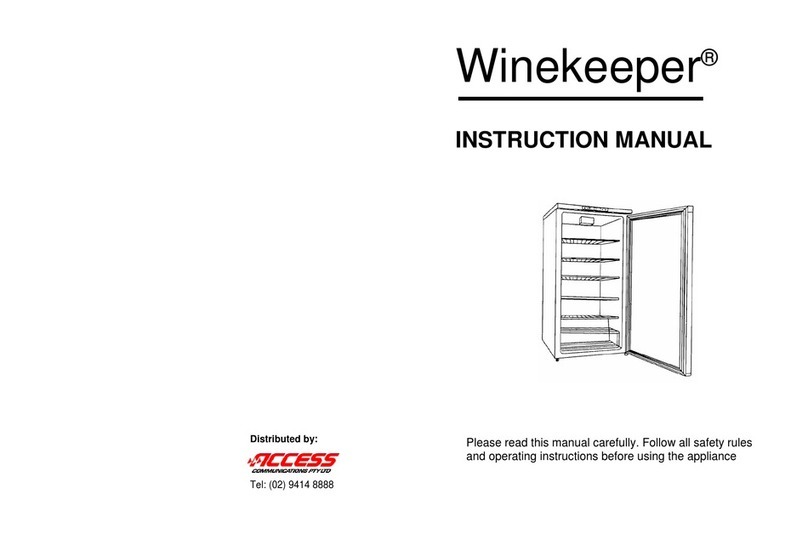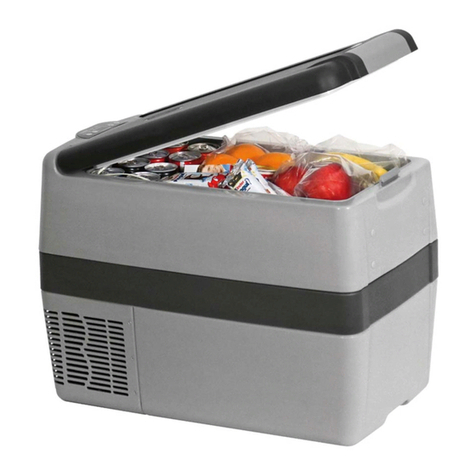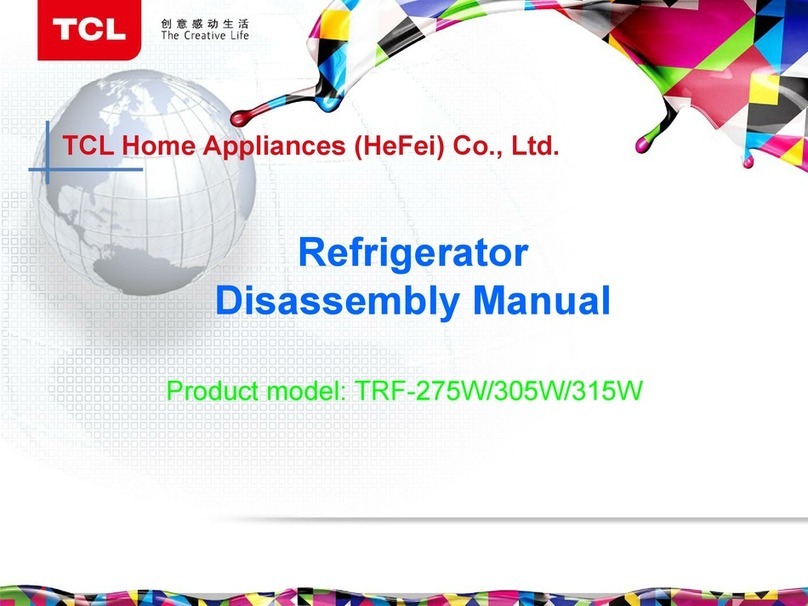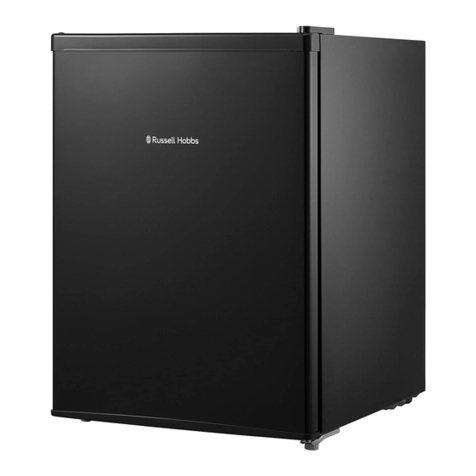Envirotainer RKN t User manual

1 (40)
www.envirotainer.com
This manual is valid for:
RKN version 120005R( ) and 120005R
RAP version 140007R( ) and 140007R
Doc. No. OM-101
Version 1.9: Jan. 16, 2009
Envirotainer RKN t / RAP t
Container
Operations Manual

Doc. No. OM-101
Version 1.9: Jan. 16, 2009 2 (40)
RECORD OF REVISION
RECORD OF REVISION
Ver. No. Issue date Revision
1.9 Jan. 16, 2009 Text and pictures updated, page 5-6.
Limitations for temperatures near or below the set
temperature (outside specification) removed, page 7.
Text and pictures updated for control units, page 15-19.
Note added for maximum amount of dry ice and for
advice in dry ice calculation, page 22.
Troubleshooting updated, page 35-36.
Correction of typo, page 37.
Dry ice tables for set temp -15°C, -10°C, -5°C, 0°C,
+10°C removed, page 24-29.

Doc. No. OM-101
Version 1.9: Jan. 16, 2009 3 (40)
TABLE OF CONTENTS
TABLE OF CONTENTS
INTRODUCTION .......................................................................................... 4
LIMITS, AMBIENT CONDITIONS ................................................................. 7
PRECONDITIONING ................................................................................... 8
CARGO / DRY ICE LOADING ..................................................................... 9
CONTAINER HANDLING GUIDELINES .................................................... 14
CONTROL UNIT OPERATION (Type 1) ..................................................... 15
CONTROL UNIT OPERATION (Type 2) ..................................................... 16
CONTROL UNIT OPERATION (Type 3) ..................................................... 18
DRY ICE CALCULATION .......................................................................... 20
DRY ICE TABLES (RKN) .......................................................................... 24
DRY ICE TABLES (RAP) .......................................................................... 27
TECHNICAL SPECIFICATION RKN t ........................................................ 30
TECHNICAL SPECIFICATION RAP t ........................................................ 32
TROUBLESHOOTING ............................................................................... 34
RKN / RAP CONTAINER CHECKLIST...................................................... 39

Doc. No. OM-101
Version 1.9: Jan. 16, 2009 4 (40)
INTRODUCTION
INTRODUCTION
Scope of manual
This manual provides information for personnel involved in the handling and transport of Envirotainer
container series RKN and RAP and is published by Envirotainer AB without warranty.
If you have any questions regarding this manual or the container, send an e-mail to
Frankfurt Operations Center +49 69 69 76 79 0, Dallas Operations Center +1 972 831 3800
Safety instructions
The container is designed to minimize hazards and prevent injury to personnel and equipment during
use. Normal precautions should be observed when handling the container locks, doors and lids. None
of the material used in the construction constitutes a personnel health risk.
The dry ice used as a refrigerant is considered a Class 9 dangerous cargo with the UN identification
number 1845 and is described as “Carbon Dioxide, Solid”.
Do not allow any exposed skin or body part to make physical contact with dry ice. Given the extreme
cold temperature of dry ice (-78.5°C / -109°F), severe frostbite can occur within seconds. Personnel
handling dry ice must use gloves or other insulating material.
Dry ice sublimates into large amounts of CO2gas. This colorless, odorless gas is heavier than air and
can accumulate and displace oxygen in low areas. Do not enter areas where CO2may have
accumulated without ventilating the space.
The container
The RKN and RAP containers are temperature controlled air cargo containers used to transport
temperature sensitive cargo in the refrigerated, controlled room temperature and deep frozen product
temperature ranges. In general, the product temperature to be maintained must be less than the
ambient temperature.
The container consists of two primary parts; the cargo space and the dry ice bunker (refer to Figure
1 and Figure 2 on the following pages). A temperature sensor located in the cargo space monitors
the air temperature, and when cooling is required, a fan is activated. Air from the cargo space is drawn
around the dry ice bunker where it is cooled before re-entering the cargo space.
Dry ice is contained in a separate bunker, which prevents carbon dioxide gas from entering the cargo
space and allows personnel to add dry ice to the container without disturbing the cargo area.
The cooling system uses dry ice as a refrigerant and D-cell alkaline batteries to power the control unit
and fan(s). The RKN uses one fan for air distribution while the RAP uses two fans.
The RKN is a fork liftable LD-3 air cargo container designed to hold one pallet (EUR 1200 x 800 mm
/ US 48 x 40 in) of cargo. The RAP is an LD-9 air cargo container designed to hold four pallets
(EUR 1200 x 800 mm / US 48 x 40 in) of cargo. The RAP can be moved with a fork lift only when empty,
and must be moved with a roller bed system when it is loaded.

Doc. No. OM-101
Version 1.9: Jan. 16, 2009 5 (40)
INTRODUCTION
Figure 1 RKN Container
Manufacturer's plate
(P/N indicated)
Note!
The P/N could be 120005R or
120005R( )
Note!
This manual is only valid for P/N
120005R and 120005R( ).
For P/N 120005-01 a separate
Operations manual is required,
as procedures are different.
Dry ice bunker
Cargo area
Control unit
Placard holder
(Document pouch)
Note!
The placard holder can also be
located on the left door

Doc. No. OM-101
Version 1.9: Jan. 16, 2009 6 (40)
INTRODUCTION
Dry ice bunker
(on the rear side)
Figure 2 RAP Container
Manufacturer's plate
(P/N indicated)
Note!
The P/N could be 140007R
or 140007R( )
Cargo area
Control unit
Placard holder
(Document pouch)

Doc. No. OM-101
Version 1.9: Jan. 16, 2009 7 (40)
LIMITS, AMBIENT CONDITIONS
LIMITS,AMBIENT CONDITIONS
Specified Limits
The RKN and RAP containers are designed to maintain cargo temperatures in a range from -20°C to
+20°C (-4°F to +68°F) provided the ambient temperature is 5°C to 25°C (9°F to 45°F) higher than the
set temperature. The following conditions must apply for the container to perform to these specifications.
Maximum Operating Time without Changing Batteries
The maximum operating time for the container without changing the batteries is 72 hours. If the
container is operated outside the specified temperature limits, the fan may operate continously which
reduces the maximum operating time before batteries must be changed. An example of this case is
deep frozen cargo where it is recommended to change the batteries every 24 hours.
Exposure to Extreme Heat (25°C above the set temperature)
Avoid exposure to extreme heat or direct sunshine as it increases the dry ice consumption rate.
Exposure to temperatures 25°C above the set temperature should be limited. Take into account
exposure to such conditions when calculating the required amount of dry ice.
Exposure to Temperatures Near or Below the Set temperature
Since the container does not heat, exposure to temperatures near or below the set temperature must
be avoided. The container must be stored in an environment where temperatures are at least 5°C (9°F)
higher than the container set temperature (not applicable to deep frozen cargo). Exposure to
temperatures near or below the set temperatures should be limited.

Doc. No. OM-101
Version 1.9: Jan. 16, 2009 8 (40)
PRECONDITIONING
PRECONDITIONING
The cargo and container must be pre-conditioned to the set temperature prior to loading. Improper
precondition will affect the container's ability to maintain cargo temperature.
Cargo Preconditioning
The cargo must be preconditioned in a temperature-controlled room to the container's set temperature
prior to loading (separating the cargo aids the preconditioning process). Once preconditioned, limit
exposure of the cargo to ambient temperatures during the loading process.
Container Preconditioning
Prior to preconditioning, a functional test of the control unit should be performed.
There are three recommended practices for container preconditioning:
Precondition with a temperature-controlled room
1) Turn off the control unit or remove the batteries from the holder.
2) Place the container in a temperature-controlled room that is set to the desired temperature.
3) Open the container doors.
4) Allow at least one hour for container preconditioning before loading the cargo.
Precondition with dry ice (for refrigerated cargo)
An amount of dry ice required to cool both the container and maintain cargo temperature (as stated
in the Dry Ice Tables Section) is placed in the dry ice bunker
1) Calculate the total amount of dry ice required (for preconditioning and shipment).
2) Place batteries in the control unit and set the temperature.
3) Load the dry ice in the bunker.
4) Close the container doors.
5) Allow at least one hour for container preconditioning before loading the cargo.
Precondition with dry ice (for deep frozen cargo)
A sufficient amount of dry ice to cool the container is placed in the dry ice bunker and in the cargo area
to accelerate the preconditioning process
1) Calculate the total amount of dry ice required.
2) Place batteries in the control unit and set the temperature.
3) Load 20% of total amount of dry ice in the bunker. The remaining dry ice will be loaded with
the cargo
4) Distribute 50 kg of dry ice on a pallet in the cargo area.
5) Close the container doors.
6) Allow at least one hour for container preconditioning before loading the cargo.
pages 15-19
pages 15-19
pages
20-29
page 9
pages 15-19
pages 15-19
pages 20-29
page 9

Doc. No. OM-101
Version 1.9: Jan. 16, 2009 9 (40)
CARGO / DRY ICE LOADING
CARGO / DRY ICE LOADING
Dry ice
Dry ice shall be used wrapped or unwrapped as stated in the dry ice tables.
•Wrapped dry ice
Dry ice in paper/plastic bags. Note that the paper/plastic bag shall not be removed when
wrapped dry ice is used. Also note that cardboard boxes should not be put into the dry ice
bunker.
•Unwrapped dry ice
Dry ice without any wrapping.
Avoid using dry ice that has been exposed to ambient conditions for several days before use since the
humidity in the air condensates and freezes on the dry ice blocks, creating a crust of ice and thereby
reducing the effectiveness of the dry ice.
Dry Ice Loading
To load dry ice in the container bunker:
1) Unlatch and open the dry ice bunker lid.
2) Evenly distribute dry ice blocks weighing between 2 kg and 7 kg on the bottom of the bunker.
3) Close and secure the dry ice bunker lid.
Re-Icing the Container
In the event of delays, long transit times or extreme ambient temperatures, it may be necessary to
add dry ice to the container. To "re-ice" the container:
1) Unlatch and open the dry ice bunker lid.
2) Discard any remaining dry ice in the bunker.
3) Put the correct amount of dry ice in the bunker.
4) Close and secure the dry ice bunker lid.

Doc. No. OM-101
Version 1.9: Jan. 16, 2009 10 (40)
CARGO / DRY ICE LOADING
Figure 3
Figure 4
Cargo Temperature Recording
The temperature indicated on the control unit is not the product temperature but the temperature of
the air inside the container. When cargo temperature monitors are used, they must be placed in or
among the cargo boxes (temperature monitors placed outside the cargo does not measure the
product temperature). It is also recommended to record ambient temperatures by placing a
temperature monitor in the container document pouch.
Cargo Loading - General Guidelines
Observe the following guidelines when loading the container:
1) Use the door straps (Figure 3) to hold the doors open when loading.
2) Load the cargo on a pallet or on spacers at least 2 cm high to allow a proper airflow.
3) Ensure that the fan is not blocked by the cargo.
4) Do not position the cargo outside the loading area (indicated with red lines).
5) Ensure proper weight distribution.
6) Secure the cargo to the tie-down brackets (Figure 4 & 5) using straps.
Figure 5

Doc. No. OM-101
Version 1.9: Jan. 16, 2009 11 (40)
CARGO / DRY ICE LOADING
Cargo Loading - Refrigerated / Controlled Room Temperature
When the container is preconditioned with a temperature-controlled room
Container loading takes place in the temperature-controlled room used for preconditioning.
1) Ensure that the container is preconditioned to the required cargo temperature.
2) Load the container.
3) Close and lock the doors; secure with seals if applicable.
4) Move the container from the temperature-controlled room.
5) Immediately reinstall batteries, check battery voltage and set the temperature.
6) Immediately load the dry ice in the bunker.
7) Place any shipping documents or checksheets in the container document pouch.
When the container is preconditioned with dry ice
Dry ice is in the container prior to cargo loading, which takes place at warehouse or ambient conditions.
1) Ensure that the container is preconditioned to the required cargo temperature.
2) Open the container doors (minimize the time the container doors are open during loading).
3) Load the container.
4) Close and lock the doors; secure with seals if applicable.
5) Place any shipping documents or checksheets in the container document pouch.
page 10
pages 15-19
page 9
page 10

Doc. No. OM-101
Version 1.9: Jan. 16, 2009 12 (40)
CARGO / DRY ICE LOADING
Cargo Loading - Frozen
By placing dry ice in the cargo area, the container keeps cargo frozen when ambient temperatures
exceed the specified temperature limits, however a lower temperature limit can not be controlled.
When the container is preconditioned with a temperature controlled room
The container should be loaded in the temperature-controlled room used for preconditioning.
1) Ensure that the product and all packing material is preconditioned for at least one week prior
to loading.
2) Ensure that the container is preconditioned to the required cargo temperature.
3) Load the container.
If the product is to be loaded on a pallet:
• Load the cargo on a pallet and distribute 80% of the dry ice on top of the cargo using one of
the following methods:
• Put dry ice in boxes and secure on top of the cargo with plastic wrap or by other
means.
• Distribute dry ice on top of the cargo and secure with plastic wrap or by other
means.
• Put the pallet into the container.
• Put any remaining dry ice in boxes and load around the cargo on at least 2 cm high spacers
to allow air flow.
If the product is to be hand loaded directly in the container:
• Put at least 2cm spacers on the floor of the container
• Load the cargo and distribute 80% of the dry ice on top of the cargo during the loading
process in one of the following methods:
• Put dry ice in boxes and secure on top of the cargo with plastic wrap or by other
means.
• Distribute dry ice on top of the cargo and secure with plastic wrap or by other
means.
• Put any remaining dry ice in boxes and load around the cargo on at least 2 cm high spacers
to allow air flow
4) Close and lock the doors, secure with seals if applicable.
5) Remove the container from the temperature-controlled room.
6) Load remaining 20% of the dry ice in the bunker.
7) Reinstall batteries, check battery voltage and set the temperature.
8) Place any shipping documents or checksheets in the container document pouch.
page 9
pages 15-19
page 10

Doc. No. OM-101
Version 1.9: Jan. 16, 2009 13 (40)
CARGO / DRY ICE LOADING
When the container is preconditioned with dry ice
Dry ice is in the container prior to cargo loading which takes place at warehouse or ambient conditions.
1) Ensure product and all packing material is preconditioned for at least one week prior to
loading.
2) Ensure that the container is preconditioned to the required cargo temperature.
3) Open the container doors (minimize the time the container doors are open during loading).
4) Remove the pallet with dry ice used for preconditioning from the cargo area.
5) Load the container and ensure proper weight distribution.
If the product is to be loaded on a pallet:
• Load the cargo on a pallet and distribute the remaining 80% of the dry ice (20% already in
bunker) on top of the cargo using one of the following methods:
• Put dry ice in boxes and secure on top of the cargo with plastic wrap or by other
means.
• Distribute dry ice on top of the cargo and secure with plastic wrap or by other
means.
• Put the pallet into the container.
• Put any remaining dry ice in boxes and load around the cargo on at least 2 cm high spacers
to allow air flow.
If the product is to be hand-loaded directly in the container:
• Put at least 2cm high spacers on the floor of the container.
• Load the cargo and distribute the remaining 80% of the dry ice (20% already in bunker) on
top of the cargo in one of the following methods:
• Put dry ice in boxes and secure on top of the cargo with plastic wrap or by other
means.
• Distribute dry ice on top of the cargo and secure with plastic wrap or by other
means.
• Put any remaining dry ice in boxes and load around the cargo on at least 2 cm high spacers
to allow air flow.
6) Close & secure the container doors.
7) Place any shipping documents or checksheets in the container document pouch.
After Loading Any Type of Cargo
1) Confirm the correct temperature setting on the control unit (refer to Control Unit Operation
Section).
2) Allow up to one hour for the container temperature to stabilize around the set temperature.
3) Confirm that all doors and covers are closed and latched.
4) Ensure that the container is stored in accordance with the specified limits and ambient
conditions.
page 10

Doc. No. OM-101
Version 1.9: Jan. 16, 2009 14 (40)
HANDLING AND TRANSPORT
CONTAINER HANDLING GUIDELINES
General Guidelines
Observe the following guidelines when handling the container:
1) RKN containers can be forklifted when empty or loaded.
2) RAP containers can be forklifted only when empty; the use of slave pallets is recommended.
3) Use the straps outside the corners of the container to handle the container on roller beds.
4) Ensure that the container is handled in accordance with the specified limits and ambient conditions.
5) If delays occur during transit, it may be necessray to add additional dry ice to the bunker.
Ground Transport Precautions
Ensure that the container is transported in an environment where temperatures are between 5°C to
25°C higher than the set temperature or limit exposure to cold/warm temperatures.
If a temperature-controlled truck is used, we recommend setting the temperature of the truck 10°C
higher than the set temperature of the container.
This section is not applicable to deep frozen cargo.
Aircraft Transport Precautions
Observe the following guidelines when transporting the container:
1) Store the container at airport warehouse temperatures at least 5°C higher than the set temperature.
2) Limit time on the tarmac during aircraft loading (to avoid temperature extremes and direct sunlight).
3) Provide Notice to Captain (NOTOC) and note on the Air Way Bill (not applicable to frozen cargo):
"Maintain 15-20°C aircraft cargo hold. Do not position container near the cargo door.”
4) The shipper should comply with airline regulations for shipping dry ice.
Unloading
Before unloading the container, check for damage. Unload the container by unlocking and
opening the doors. After unloading:
1) Remove the batteries and follow local regulations for disposal.
2) Remove and dispose of any remaining dry ice. If local regulations allow it, the dry ice may be
placed outdoors. It will dissolve quickly.
page 7

Doc. No. OM-101
Version 1.9: Jan. 16, 2009 15 (40)
CONTROL UNIT OPERATION (Type 1)
CONTROL UNIT OPERATION (Type 1)
Mounting Batteries
1) Open the door to the control unit.
2) Place 16 "D-cell" alkaline batteries in the holder.
Voltage 1.5V
IEC / JIS LR 20
ANSI / NEDA 13A
3) Ensure proper battery polarity (Figure 6).
Start the control unit
1) Set the "ON/OFF" switch to "ON"; the green indicator should illuminate and display shows the
temperature in the container.
Setting Temperature
1) Set the "C°/F°" switch to Celsius or Fahrenheit.
2) Set knob to the desired temperature.
Battery Voltage Check
1) If the green indicator is not lit, replace the batteries (refer to the Troubleshooting Section).
Functional Test
1) Check that the green indicator is lit and the temperature is shown on the display.
2) Set temperature 3°C lower than actual temperature by turning the knob; the fan will start.
3) Check for air discharge from air guides in the container ceiling (Figure 7).
4) Set temperature 3°C higher than actual temperature by turning the knob; the fan will stop.
Note that if it's not possible to set the temperature 3°C lower / higher than
the actual temperature due to high ambient temperatures, the functional
test should be performed after the dry ice is loaded.
+
-
+
-
-
+
-
+
"On/Off"
button
Green
indicator
Display
Figure 8Figure 7
Figure 6
Check for air
discharge
"°C/°F"
switch
Set temperature
knob

Doc. No. OM-101
Version 1.9: Jan. 16, 2009 16 (40)
CONTROL UNIT OPERATION (Type 2)
CONTROL UNIT OPERATION (Type 2)
Mounting Batteries
1) Open the door to the control unit.
2) Place 16 "D-cell" alkaline batteries in the holder.
Voltage 1.5V
IEC / JIS LR 20
ANSI / NEDA 13A
3) Ensure proper battery polarity (Figure 9).
Start the control unit
The Control unit automatically starts when batteries have been installed.
Setting Temperature
1) Press the "C°/F°" button to switch between Celsius or Fahrenheit.
2) Press the set temperature button ("+/-") to enter set temperature mode.
Note!
The Set temperature mode is activated for 10 seconds. If the display returns to default mode
while adjusting the temperature, the new set temperature was not saved.
3) Press the "plus" or "minus" buttons to change the set temperature.
4) Press the set temperature button ("+/-") to confirm and return to default mode.
5) Check that the set temperature is correct on the display.
Figure 9
+
-
+
-
-
+
-
+
5.5°C
*
5.0
11.2V
11.3V
Control unit
display
Set temperature
button "+/-"
"minus"
button
"°C/°F"
button
"plus"
button
Figure 10

Doc. No. OM-101
Version 1.9: Jan. 16, 2009 17 (40)
CONTROL UNIT OPERATION (Type 2)
Battery Voltage Check
1) The current battery status for the two battery packs is continously shown in the default view.
2) Check the battery voltage for the two battery packs. New batteries should read at least 11V. The
minimum allowable battery voltage when the container is in use is 9V; change the batteries as
necessary.
Functional Test
1) Set temperature 3°C lower than actual temperature; the fan will start.
2) Check for air discharge from air guides in the ceiling (Figure 11).
3) Set temperature 3°C higher than actual temperature; the fan will stop.
Note that if it's not possible to set the temperature 3°C lower / higher than
the actual temperature due to high ambient temperatures, the functional
test should be performed after the dry ice is loaded.
Figure 11
Check for air
discharge

Doc. No. OM-101
Version 1.9: Jan. 16, 2009 18 (40)
CONTROL UNIT OPERATION (Type 3)
+
-
+
-
-
+
-
+
Control unit
display
"Set"
button
Temp 5.0°C
Set temp 5.0°C
"minus"
button
"Menu/Enter"
button
"On/Off"
button
"plus"
button
Figure 13
CONTROL UNIT OPERATION (Type 3)
Mounting Batteries
1) Open the door to the control unit.
2) Place 16 "D-cell" alkaline batteries in the holder.
Voltage 1.5V
IEC / JIS LR 20
ANSI / NEDA 13A
3) Ensure proper battery polarity (Figure 12).
Start the control unit
1) Press the ”On/Off" button.
2) Make sure the default mode is visible on the display. The default mode show "Container temp"
and "Set temp".
Setting Temperature
1) To change between Celsius and Fahrenheit:
• Press the "Menu/Enter" button; the display shows "Change to °F" or "Change to °C".
• Press the "minus" button to change between Celsius and Fahrenheit.
• Press the "Menu/Enter" button to confirm the change and return to default mode.
2) Press the "Set" button to enter set temperature mode.
Note!
The Set temperature mode is activated for 10 seconds. If the display returns to default mode
while adjusting the temperature, the new set temperature was not saved.
3) Press the "plus" or "minus" buttons to change the set temperature. Hold down the buttons to speed
up the change.
4) Press the "Set" button to confirm and return to default mode.
5) Check that the set temperature is correct on the display.
Figure 12

Doc. No. OM-101
Version 1.9: Jan. 16, 2009 19 (40)
CONTROL UNIT OPERATION (Type 3)
Battery Voltage Check
1) To check the battery voltage, press the "Menu/Enter" button twice.
2) Check the battery voltage for the two battery packs. New batteries should read at least 11V. The
minimum allowable battery voltage when the container is in use is 9V; change the batteries as
necessary.
3) Press the "Menu/Enter" button again to return to default mode.
Functional Test
1) Set temperature 3°C lower than actual temperature, the fan will start.
2) Check for air discharge from air guides in the ceiling (Figure 14).
3) Set temperature 3°C higher than actual temperature, the fan will stop.
4) If the fan alarm is displayed (Figure 15) the fan is malfunctioning and
the container should be repaired.
Temp 5.0°C
Set temp 5.0°C
Fan alarm
Figure 15Figure 14
Check for air
discharge

Doc. No. OM-101
Version 1.9: Jan. 16, 2009 20 (40)
DRY ICE CALCULATION
DRY ICE CALCULATION
Calculate Dry Ice Amount for Container Preconditioning
Only authorized persons should perform dry ice calculations. It is strongly recommended to have
Envirotainer perform the calculation.
To calculate the amount of dry ice needed to precondition the container:
1) Note the container temperature (in Celsius) prior to preconditioning. Although using the actual
container temperature is preferred, an estimate based on the ambient temperature is acceptable.
2) Determine the set temperature (in Celsius) of the product.
3) Subtract "set temperature" from "container temperature" to obtain the "temperature difference".
4) Refer to graph (Figure 16) and locate the "temperature difference" on the horizontal axis.
5) Read up vertically on the graph until reaching the line that corresponds to the container type.
6) Read across to the left to obtain dry ice quantity (in Kilograms) from the vertical axis.
7) This is the amount of dry ice required to precondition the container and should added to the dry
ice necessary to maintain the product temperature, which is obtained from the Dry Ice Tables.
Figure 16
This manual suits for next models
1
Table of contents
Popular Refrigerator manuals by other brands
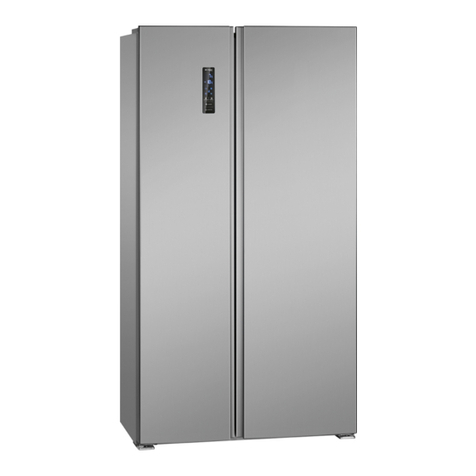
BOMANN
BOMANN SBS 7335 IX instruction manual
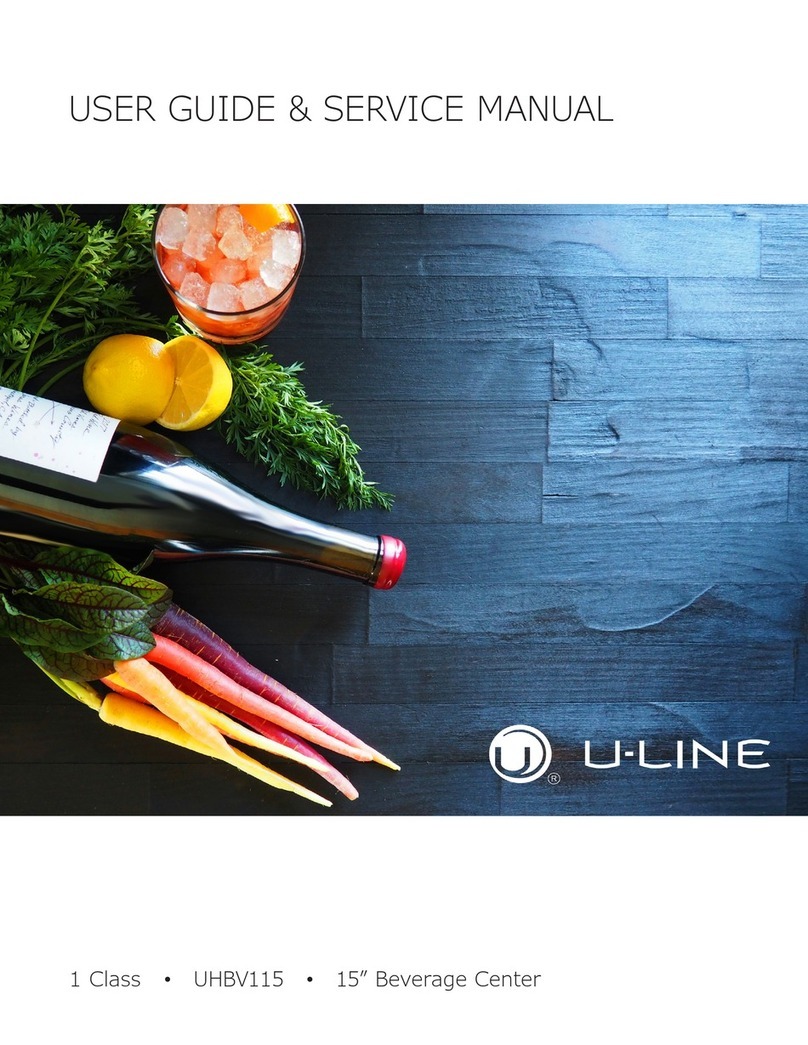
U-Line
U-Line UHBV115 User guide & service manual
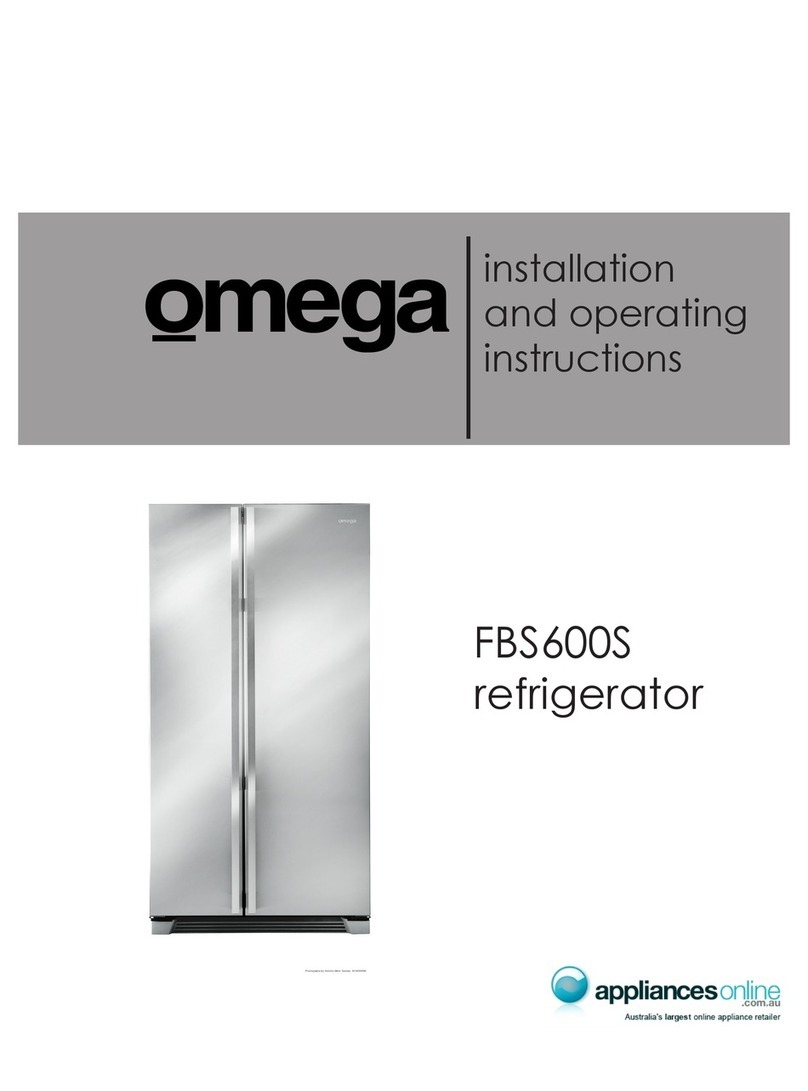
Omega
Omega FBS600S Installation and operating instructions
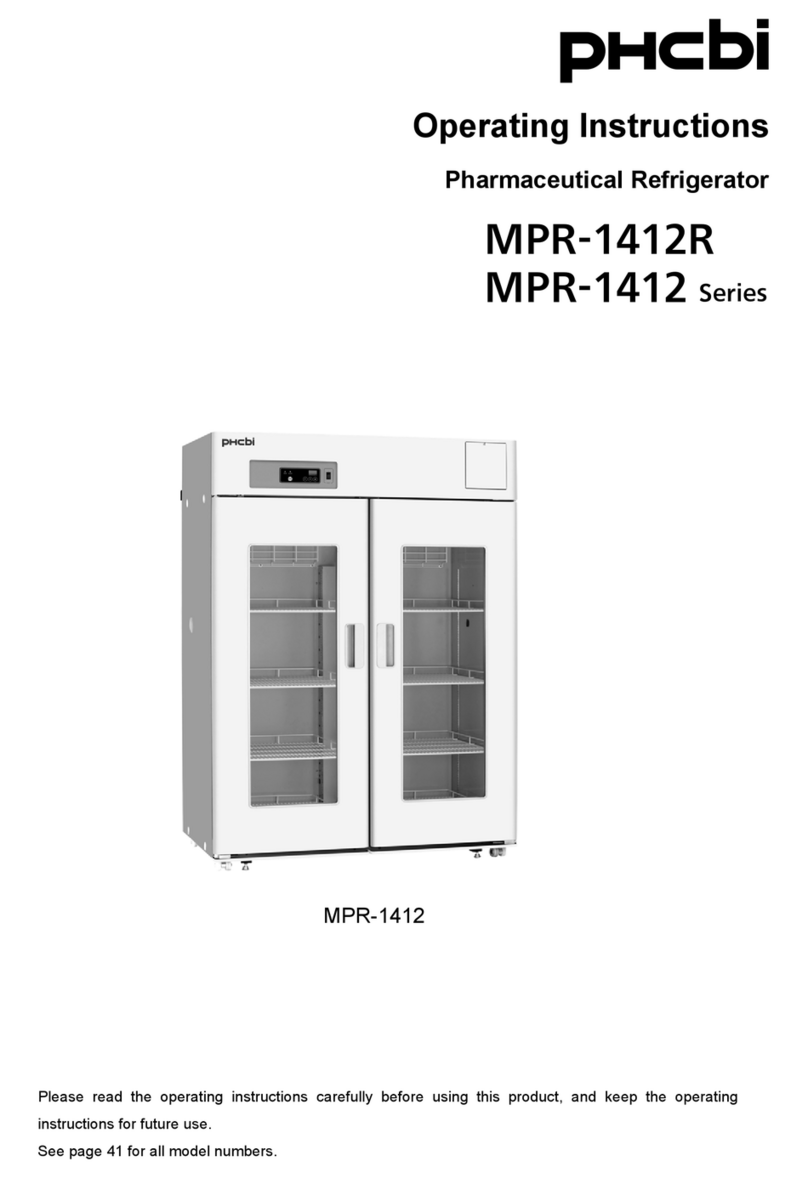
Phcbi
Phcbi MPR-1412R Series operating instructions

ConServ
ConServ FR 1400SS-N owner's manual

montpellier
montpellier MAB365R Installation and operating instructions

Maytag
Maytag MZD2663KEW - 26 cu. Ft. Wide-By-Side... Repair parts list
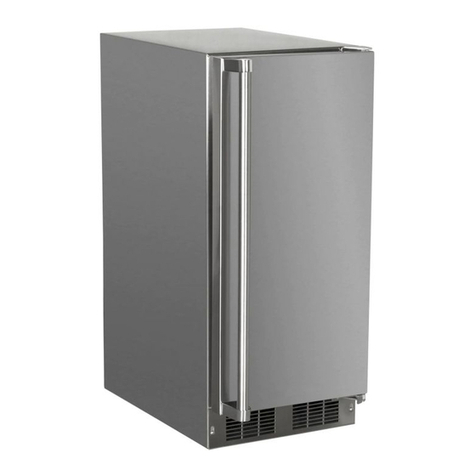
Marvel
Marvel MACL415 owner's guide
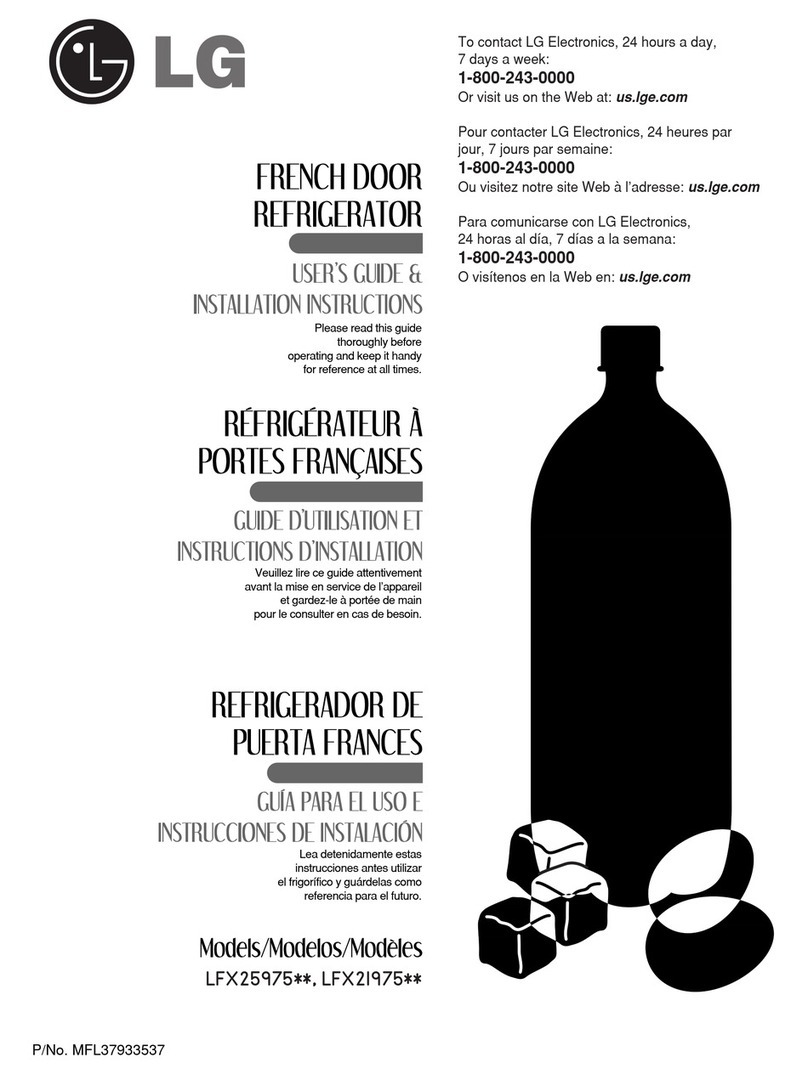
LG
LG LFX25975SW - 24.7 cu. ft. Refrigerator Guía para el uso e instrucciones de instalación
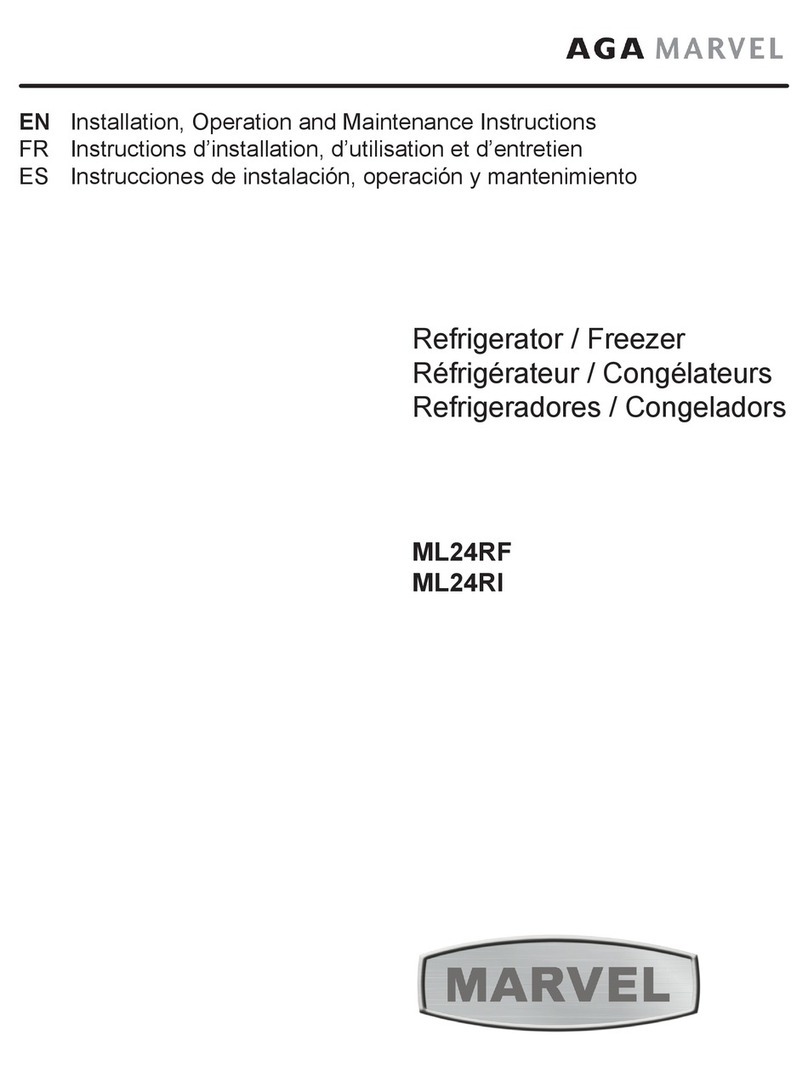
AGA
AGA ML24RF Installation, operation and maintenance instructions
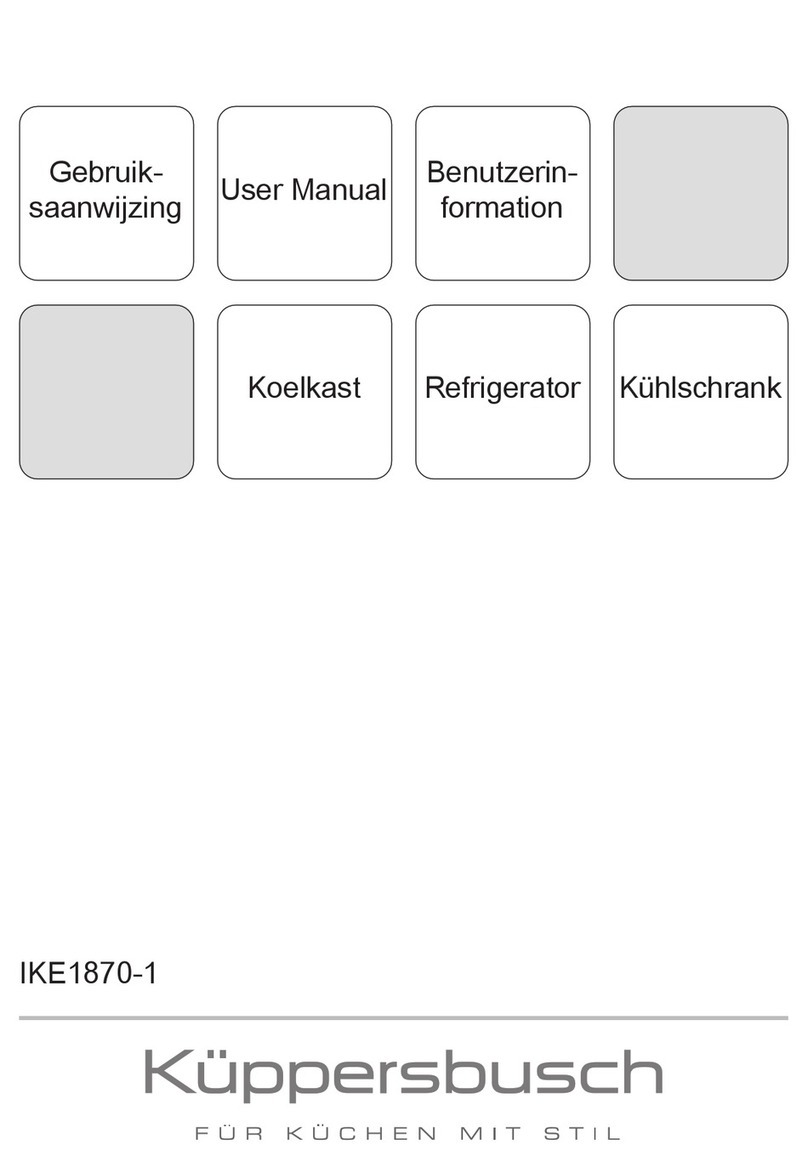
Kuppersbusch
Kuppersbusch IKE1870-1 user manual

Beko
Beko GN163220 user manual
